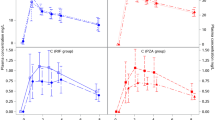Summary
Two dosages of clarithromycin were compared for treatment of disseminatedMycobacterium avium disease of AIDS patients: high-dose (HD): 1,000 mg or 750 mg b.i.d. according to body weight, and low-dose (LD): 1,000 mg or 750 mg q.d. Patients with high probability ofM. avium positive blood culture on day 0 received a 42-day clarithromycin treatment with HD (n=27) or LD (n=28) at random after stratification according to body weight. Assessment procedures, including quantitative blood cultures, were performed at days 14, 28 and 42. Forty-five patients were eligible for clinical and 28 for bacteriological evaluation. Bacteriological success was observed in 12 HD and 11 LD patients, partial success in one HD and two LD and failure in none of the HD and two LD (p=0.33). Between days 0 and 42, log decreases in CFU counts/ml were (mean ± SD) 3.13±0.82 (HD) and 2.67±1.8 (LD) (p=0.38). Fever and night sweats significantly improved similarly in both groups; no change in spleen and liver size was observed on CT scans. Eight patients died during the study but no death was reported as drug related. Sixteen patients (HD=6, LD=10) discontinued the treatment because of side effects. A trend towards improved bacteriological effectiveness and reduced tolerance was observed in the HD group but the difference was not significant. With a power of 0.70, no dose effect was demonstrated between the two tested dosages. A daily dose of 1,000 mg clarithromycin was tested in drug combinations to treat disseminatedM. avium infection in AIDS patients.
Similar content being viewed by others
References
Joint position paper of American Thoracic Society and Centers for Disease Control Mycobacterioses and the acquired immune deficiency syndrome. Am. Rev. Respir. Dis. 136 (1987) 492–496.
Nigthingale S. D., Byrd, L. T., Southern, P. M., Jockusch, J. D., Cal, S. X., Wynne, B. A. Incidence ofMycobacterium avium-intracellulare complex bacteremia in human immunodeficiency virus-positive patients. J. Infect. Dis. 165 (1992) 1082–1085.
Young, L. S., Wiviott, L., Wu, M., Kolonosky, P., Bolan, R., Inderlied, C. B. Azithromycin for treatment ofMycobacterium avium-intracellulare complex infection in patients with AIDS. Lancet 338 (1991) 107–1109.
Dautzenberg, B., Truffot, C., Legris, S., Meyohas, M. C., Legris, S., Mercat, A., Chevret, S., Grosset, J. Activity of clarithromycin againstMycobacterium avium infection in patients with the acquired immune deficiency syndrome. Am. Rev. Respir. Dis. 44 (1991) 564–569.
Kemper, C., Havlir, D., Haghighat, M., Dube, M.: Effect of ethambutol (EMB), rifampin (RIF), and clofazimine (CLO), given singly, onM. avium bacteremia in AIDS. 8th International Conference on AIDS, 19–24 July 1992, Amsterdam (1992), abstr. PoB3087.
Sullam, P., Gordin, F., Wynne, B., Smith, J., Schoenfelder, J. and the Rifabutin Study Group: Efficacy of rifabutin in the treatment ofMycobacterium avium complex (MAC) bacteremia. 9th International Conference on AIDS, Berlin (1993), abstr. BO7-1238.
Chaisson, R. E., Benson, C., Dube, M., Heiffets, L. B., Korvick, J. A., Elkins, S., Smith, T., Craft, C., Sattler, F., and theAIDS Clinical Trial Group Protocol 157 Study Team Clarithromycin therapy for bacteremicMycobacterium avium complex disease. A randomized double-blind, dose-ranging study in patients with AIDS. Ann. Intern. Med. 121 (1994) 905–911.
Dautzenberg, B., Truffot, Ch., Mignon, A., Rozenbaum, W., Katlama, C., Perronne, Ch., Parrot, R., Grosset, J. and theGETIM (Groupe d'Etude et de Traitement des Infections à Mycobactéries Résistantes) Rifabutin in combination with clofazimine, isoniazid and ethambutol in the treatment of AIDS patients with infections due to non tuberculous mycobacteria. Tubercle 172 (1991) 168–175.
Dautzenberg, B., Saint Marc, Th., Meyohas, M., Eliazewitch, M., Haniez, F., Rogues, A., De Wit, S., Cotte, L., Chauvin, J., Grosset, J. Clarithromycin and other antimycobacterial agents in the treatment of disseminatedMycobacterium avium infections in patients with acquired immunodeficiency syndrome. Arch. Intern. Med. 153 (1993) 368–373.
Jacobs, M. R., Morrissey, A. M., Bajaksouzian, S.: Changes in quantitative blood cultures, colonial morphology and susceptibility ofMycobacterium avium during therapy. 33rd Interscience Conference on Antimicrobial Agents and Chemotherapy, 17–20 October, American Society for Microbiology, New Orleans (1993), abstr. 1124.
Jacobson, M. A., Yajko, D., Northfeldt, D., Charlebois, E., Gary, D., Brosgart, C, Sanders, C. A., Hadley, W. K. Randomized, placebocontrolled trial of rifampin, ethambutol, and ciprofloxacin for AIDS patients with disseminatedMycobacterium avium complex infection. J. Infect. Dis. 168 (1993) 112–119.
Kemper, C., Meng, T. C., Nussbaum, J., Chiu, J., Feigal, D. F., Bartok, A. E., Leedom, J. M., Tilles, J. G., Deresinski, S. C., McCutchan, J. A. Treatment ofMycobacterium avium complex bacteremia in AIDS with a four drug regimen: rifampin, ethambutol, clofazimine, and ciprofloxacin. Ann. Intern. Med. 116 (1992) 466–472.
Lucas, C. R., Mijah, A. M., Sandland, A. M., Grayson, M. L., Dwyer, B. W.: Evidence that drug therapy may be effective inMycobacterium avium intracellulare (MAI) bacteremia. 4th International Conference on AIDS, Stockholm (1988), abstr. 7534.
Masur, H. Recommendations on prophylaxis and therapy for disseminatedMycobacterium avium complex disease in patients infected with the human immunodeficiency virus. N. Engl. J. Med. 329 (1993) 898–904.
Dautzenberg, B., Saint Marc, Th., Durant, J., Reynes, J., Meyohas, M., Legrand, M. F., Truffot, C., Chauvin, J. P. Traitement de 173 malades VIH+ atteints d'infection disséminée àM. avium intracellulare par une association incluant la clarithromycine. Rev. Mal. Resp. 12 (1994) 268–375.
Ruf, B., Schurmann, D., Mauch, H., Jautzke, G., Fehrenbach, F. J., Pohle, H. D. Effectiveness of the macrolide clarithromycin in the treatment ofMycobacterium avium complex infection in HIV-infected patients. Infection 20 (1992) 267–272.
Saint Marc, T., Marneff, E., Touraine, J. L. Traitement des infections àMycobacterium avium intracellulare (MAIC) par la double association clarithromycine clofazimine: à propos de 18 cas. Press Méd. 15 (1993) 154–157.
Truffot-Pernot, C. H., Ji, B., Grosset, J. Effect of pH on thein vitro potency of clarithromycin againstMycobacterium avium complex. Antimicrob. Agents Chemother. 35 (1991) 1677–1678.
Author information
Authors and Affiliations
Rights and permissions
About this article
Cite this article
Dautzenberg, B., Truffot-Pernot, C., Grosset, J. et al. A randomized comparison of two clarithromycin doses for treatment ofMycobacterium avium complex infections. Infection 25, 16–21 (1997). https://doi.org/10.1007/BF02113501
Received:
Accepted:
Issue Date:
DOI: https://doi.org/10.1007/BF02113501



